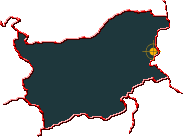|
|
|
 Name:
Несебър (Nesebâr, Nesebar, also Nessebar). Ancient Greeks founded a colony here
and named it Mesambria; later on Bulgarians and Ottomans transformed the Greek name into
Mesemvrija. The present name was given in the year 1930. The spelling Nesebar is the most
common one.
Name:
Несебър (Nesebâr, Nesebar, also Nessebar). Ancient Greeks founded a colony here
and named it Mesambria; later on Bulgarians and Ottomans transformed the Greek name into
Mesemvrija. The present name was given in the year 1930. The spelling Nesebar is the most
common one.
Location:
Nesebar occupies a small, rocky island in the Black Sea, only to be connected with the mainland by an (artificial) isthmus.
The town can be found between →Varna (around 90 km) and
→Burgas (about 25 km) almost in the middle of the Bulgarian part of the Black Sea coast.
There's another interesting old town only a few kilometres south of Nesebar, called Pomorie.
To the north, touristy Sunny Beach stretches along the Sea.
Population: less than 20,000 (incl. the new town)
Orientation:
Nesebar is clearly divided into Old Nesebar, ie the historic old city core occupying the entire
peninsula (ex-island), and New Nesebar sprawling along the coastline on the mainland. Since the alleys of Old Nesebar are
too narrow, visitors are not allowed to enter by car. But there's a conveniently located parking lot near the entrance to the
old city. New Nesebar is not really interesting. Old Nesebar on the other hand is a pleasant melange of some very old houses and
partially wooden houses built 200 to 300 years ago, accompanied by uneven cobbled streets. The entire old town centre has been
declared World Cultural Heritage by the UNESCO.
The old town is almost romantic, but be aware that you'll have to share this place with countless tourists - several million visitors
flock to Old-Nesebar every year. Especially in summer it's virtually impossible to enjoy a quiet walk through the alleys. However,
there's a good reason for that - Nesebar is indeed somewhat of a must-see.
History:
At first there was a Thracian settlement, with remainings that can be dated back to the
2nd millenium BC. The island was much bigger than it is today - about one third of the land was lost due to coastal erosion.
Thracians erected a first harbour and named the place Menabria. During the 6th century BC,
the long Greek period began. Dorian Greeks founded a colony in Menabria and used the old Thracian name. Menabria then was
a powerful city-state with its own fleet, its own currency, numerous temples and a fortification system. Parts of those can still
be seen. In 72 BC, the Roman empire conquered Thracia and Nesebar. The town Anchialos (present-day Pomorie),
south of Nesebar, outstripped Mesambria (Menabria was renamed again). Production and trade
in Mesambria declined, and the town began to crumble. Things got better under the Byzantine reign between the 4th and 7th century AD.
New basilicas were erected and trade reactivated. Furthermore, fortification systems were extended. Mesambria became an
important fleet base. Things didn't change a lot during the First Bulgarian Empire and the following Ottoman occupation.
It remained an important place, with only a slight change of the name: Now, the town was called Mesemvrija.
During the Second Bulgarian Empire in the 14th century, Mesemvrija reached its heyday. The citizens started to build on the
mainland as well.
The decline of the town started with the new Ottoman occupation in the 14th century. During the next five centuries,
Mesemvrija was degraded to just another small town in the vast Ottoman empire. After being liberated by Russian troops in
1829, many Greek and Turkish inhabitants fled the place. Later, Nesebar became a forgotten place with just a few fishermen.
Around the year 1900, only 1900 people lived in Nesebar - 95% of them were Greeks. The demographic situation kept on changing.
Greeks left the place and were soon outnumbered by Bulgarians. In the 1930ies, people discovered Nesebar's quality as a
seaside resort. In addition to wine production and fishing, tourism slowly became an important source of income.
During the 1960ies, the restoration of the old city centre started. This was rewarded in 1983, when the UNESCO declared
Old Nesebar a world cultural heritage - quite early for a place in Eastern Europe.
Today, most people live in New Nesebar. The entire town can lodge around 15,000 visitors at the same time - almost as many as
there are inhabitants.
Getting there:
Nesebar lies on the main road between →Varna and →Burgas, so it's
very easy to get there by bus or car. As mentioned above, buses and cars are not allowed to enter the peninsula. Trains do not
operate in the area. The only alternative is a ferry running between
→Varna and →Burgas, but rumours say that
the ferry service was discontinued. If there's a ferry, I'm sure that it only operates in summer, so it's worth checking before.
By the way, the International Airport of →Burgas is just 20 km away.
|